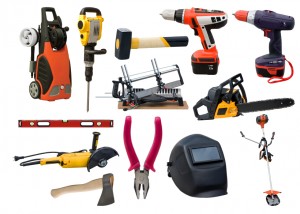RFID Tool Tracking
RFID Tool Tracking. Radio Frequency Identification or RFID tool tracking is a relatively new implementation of an established technology that uses wireless communication to transfer data from an electronic tag, called an RFID tag, that is attached to an object (tool) using a reader to recognize and track the object. The reader does not have to be within close proximity because some RFID tags can be read from several feet away (up to 300 ft). RFID is a much more efficient and improved method to identify an object than the manual course; or even the implementation of the bar code systems which have been in use since 1970.
For the most part, the bar code systems are currently being implemented. It can be difficult or impractical to read all of the bar codes, as you move about and use the tools since some of them over a period of time tend to fall off or become worn.
Pencil and paper are, of course, time-consuming and can be labor intensive as well as an unproductive use of time. This system is inefficient; and can be complicated by jobs that are ongoing around the clock. It is rare that a manager has the time or has the capability to be in place to monitor the movement of all of their company’s tools 24 hours every day, so some of the tools leave the trailer without adequate explanation.
Today, RFID tool tracking software, tags and readers not only have the ability, but the capacity to offer 100 percent guarantee that they can provide the solution of monitoring these very expensive tools in a mobile environment. This solution consists of a 53-foot trailer full of gear and equipped with RFID gates in the doorway. Contractors can then go through the gate to pick up tools; and leave again with the tool in hand without delay. This will create increased efficiency within the job site.
These RFID tags are placed on the employee’s badge, as well as on all of the tools. In the software, this will link each item with a certain employee so that the job site managers can track the tools that may have disappeared. In addition, the jobsite manager will also have the knowledge if any tools have left the site; or if any tools and other items need to be replaced or recharged. This allows the company to see who has the tools, as well as if and when they were returned.

The manner in which it works is this. When a worker approaches the closed utility trailer, a monitor with three antennas on the gate, seizes the unique identification number on his employee badge. The ID is then sent via a wired connection to a computer that is located in the trailer, which is attached to the name of the employee and whether he or she has the authority to enter the trailer. If the individual is permitted to access the trailer, the door will then unlock and the worker can enter.
From this point, the process is very simple. The employee must only select the tools needed to perform their job and walk back out of the trailer. In its second pass through the gate, the employee’s ID card and the identification tag on the tool is read by the monitor. These tools or other items are then associated with the workers identification number. The RFID computer software translates the information and it connects the staff with the tools. Furthermore, it provides information to those who may be looking for a specific tool. The software can also send data alerts to the job site supervisor or the management of a company. It will notify them in the event of a tool not being returned as well as automatically send a purchase order when a predetermined maximum amount of supplies has been taken, therefore requiring replacement.
The RFID tool tracking software also allows management to analyze the use of tools in a particular work environment, and to have better information on the amount of tools and supplies that will be needed for prospective projects. These RFID tool tracking gates can be installed on existing trailers, or a business may purchase a 53-foot trailer already equipped with the RFID gate. There are also intentions to produce this technology in 40-foot shipping containers. This will enable them to be transported from one job site to another without the use of a mobile trailer.

